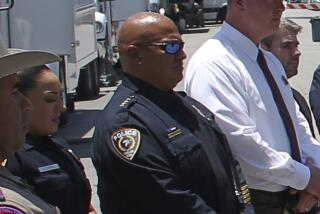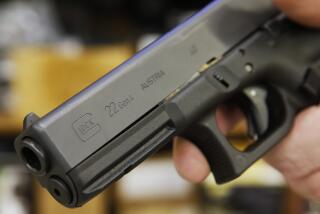School officer’s account raised doubts from start
As it turns out, Jeff Stenroos became a suspect almost as quickly as he became a hero.
While investigators scrambled to find out who shot the Los Angeles school police officer earlier this month in Woodland Hills, Stenroos told his tale haltingly, even grudgingly, officials said Friday, and, from the start, with unmistakable inconsistency.
There had been a single gunshot, Stenroos told investigators from his hospital bed. No -- several shots. That’s odd, he was told; just one shell casing was found at the scene. Oh -- well, maybe it was just the one shot after all.
He had been alerted to a suspicious-looking man peering into cars, he claimed, by a woman walking her dog. That’s who shot him, Stenroos said -- white guy, ponytail, bomber jacket.
He was asked: What happened to the woman with the dog? No idea. Actually, scratch that -- he had been asked to respond through the in-house radio system at El Camino Real High School. Who made the radio call? No idea. Are there recordings? No.
In the end, disheartened officials said Friday, it appears that Stenroos concocted the entire event -- an event that prompted a massive dragnet that locked 9,000 students in their schools, left parents fretting and fuming and inconvenienced tens of thousands of residents in the San Fernando Valley.
“The entire city was led down a path of misinformation,” Los Angeles Police Chief Charlie Beck said a day after investigators arrested Stenroos, 30, and booked him on a felony charge of filing a false police report. Stenroos was released from custody Friday after posting $20,000 bail; he could not be reached for comment.
Immediately after the Jan. 19 shooting, when Stenroos came home from the hospital, the mood was celebratory on the tidy, quiet cul-de-sac in Santa Clarita where he lives with his wife and daughter in a two-story, brown and slate-blue home.
In the neighborhood, Stenroos was known as a family man, helpful to his neighbors.
Greg Leland, 27, has lived next door for four years and recently borrowed Stenroos’ jack to fix the fender of his brother’s car. “He was the first person to offer to lend you something,” Leland said.
There was great relief that Stenroos had survived the shooting. “He said he was just really happy to be home,” Leland said, “and that it was the best day of his life.”
Quietly, though, detectives assigned to the case were considerably less jovial about the whole thing. They were having trouble confirming even a single piece of Stenroos’ account.
Police and residents, it’s now clear, had engaged in a sort of symbiosis of panic and alarm. More than 350 officers had cordoned off seven square miles and told those trying to get out that they might not be able to return to their homes for some time.
Some resorted to locking themselves inside businesses. Some schoolchildren were kept without necessities for so long they resorted to using trash cans as toilets.
When Stenroos provided a description of the suspect, sightings popped up across the west end of the Valley. One caller reported that he had vaulted over her backyard fence. SWAT officers swarmed another home after a woman reported that she had found the door to her trailer unlocked. The suspect, she was certain, was inside. He was not.
Meanwhile, Stenroos, a seven-year veteran of the school district police force, seemed to give no hint to investigators that he had been traumatized or even particularly affected by the shooting, sources close to the case told The Times, even after doctors revealed that he probably would have died had it not been for his protective vest.
Law enforcement officials noted that the details Stenroos had provided to a police sketch artist were remarkably similar to a photograph of a parolee that had been circulated among law enforcement officials in the area -- and may have come across the desk of Stenroos himself.
Publicly, city officials maintained a unified front.
At one point, for instance, they held a news conference to praise a good Samaritan who had discovered Stenroos on the ground and asked for help on the officer’s radio, and to announce a $100,000 reward for the capture of the assailant.
But investigators’ suspicions were only ratcheting up.
Repeatedly, they tried to arrange a meeting with Stenroos; they hadn’t wanted to press him too hard when he was in the hospital, and now needed to conduct a follow-up interview.
Stenroos, according to the sources, seemed to be avoiding them.
Days after the incident, Stenroos checked himself into Henry Mayo Newhall Memorial Hospital, complaining of chest pains. That piqued investigators’ concerns even more; officials began to suspect that stress was getting to him.
On Thursday, police administered what amounted to a final test of their suspicions, according to officials who spoke on the condition of anonymity because the investigation was continuing.
They invited Stenroos to participate in a news conference with Beck and Los Angeles County Sheriff Lee Baca to promote state legislation that would make it harder to buy some handgun ammunition.
The legislation -- which is real -- also would firm up California’s ban on so-called “cop-killer” bullets capable of piercing the sort of body armor that had, ostensibly, saved Stenroos’ life.
Stenroos said he would be there, then didn’t show, officials said.
Investigators confronted him a short while later. He confessed that he had concocted the story of the gunman, they added.
Beck said he was “furious” when he heard the news.
So were members of the Los Angeles City Council, which unanimously approved an emergency measure Friday demanding that Stenroos reimburse the city for the cost of the search, which involved not only the LAPD but city traffic officers, the Sheriff’s Department, the California Highway Patrol, the FBI and school officials.
The cost to taxpayers, Beck estimated, was between $400,000 and $500,000.
Parents of the children affected by the lockdown struggled, too, to comprehend the news.
“It’s just unconscionable for someone to do this,” said Sherene Hulugalle, whose 16-year-old son was locked down at El Camino and who lives about half a mile from the school.
“For grown-ups to behave like this -- I don’t know,” she said. “It’s a messed-up time.”
At this point, Beck said, investigators aren’t relying on a single element of Stenroos’ account.
They are no longer sure that he shot himself at all; it is possible that he might have shot his protective vest when it was off, intentionally bruised himself to make it appear he had been shot, then put the vest on.
If he did shoot himself, they still aren’t sure whether it was an accidental shooting that Stenroos tried to cover up so he wouldn’t get in trouble, or whether Stenroos fabricated a more elaborate hoax.
They don’t know whether the ruse was conducted next to the school or somewhere else.
It’s possible, police officials said, that the cartridge found on the street has no relationship to whatever gun was used to shoot Stenroos’ vest -- not that investigators have the gun.
--
andrew.blankstein@latimes.com
richard.winton@latimes.com
Times staff writers Shan Li, Jason Song and David Zahniser contributed to this report.
More to Read
Sign up for Essential California
The most important California stories and recommendations in your inbox every morning.
You may occasionally receive promotional content from the Los Angeles Times.











